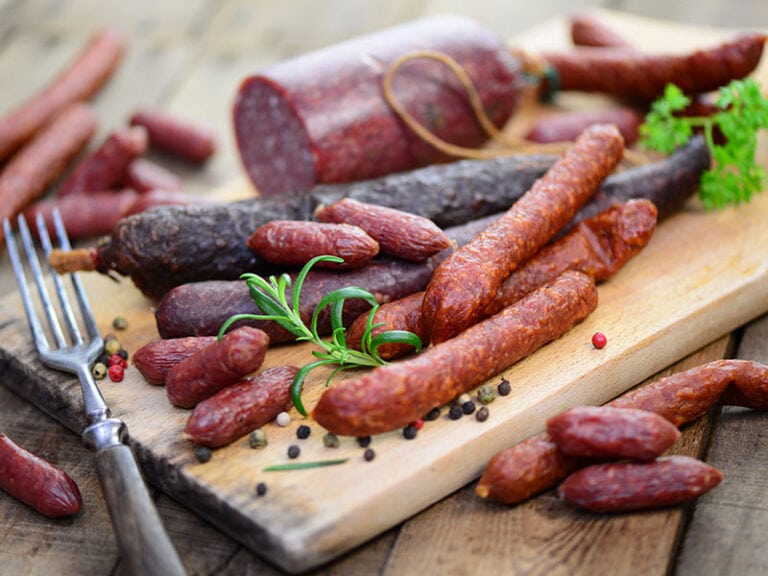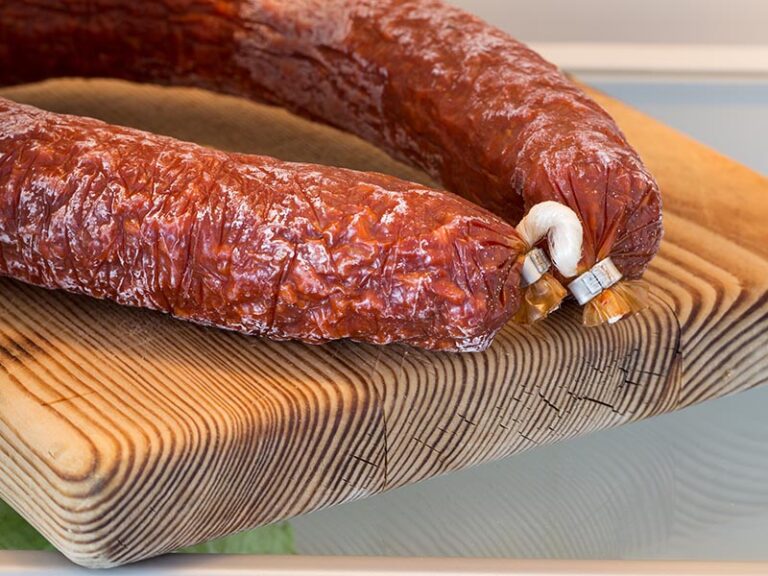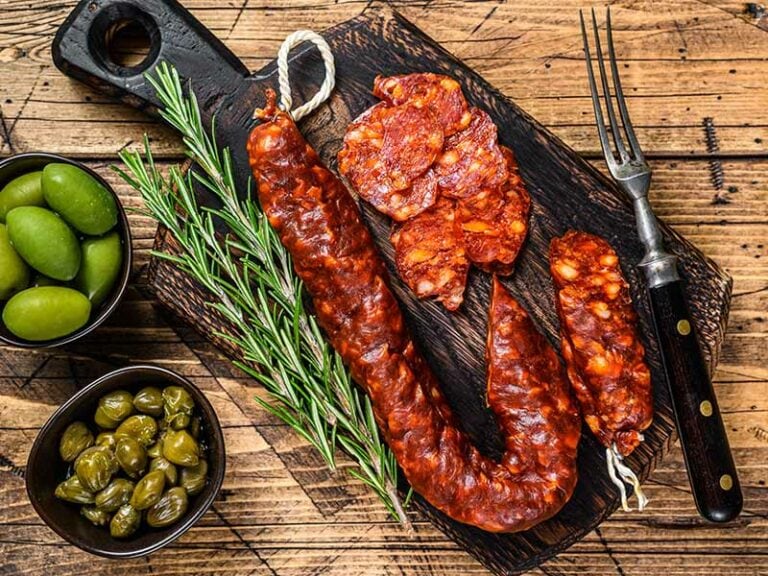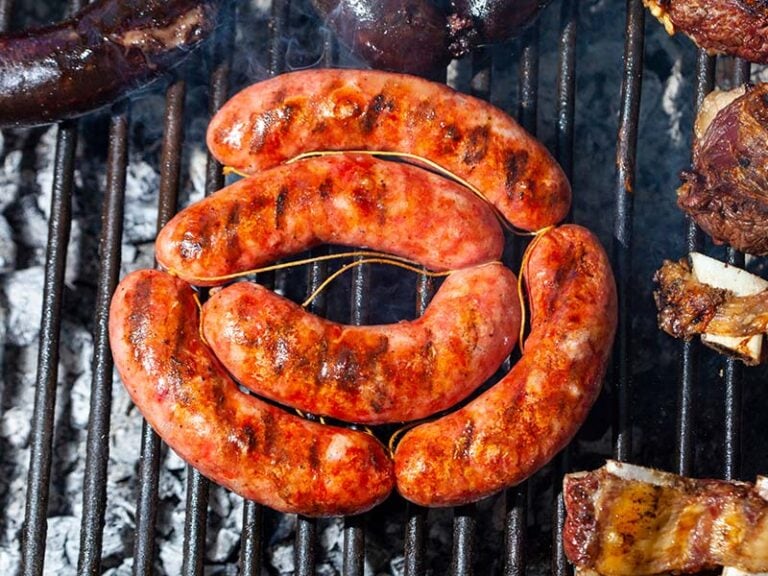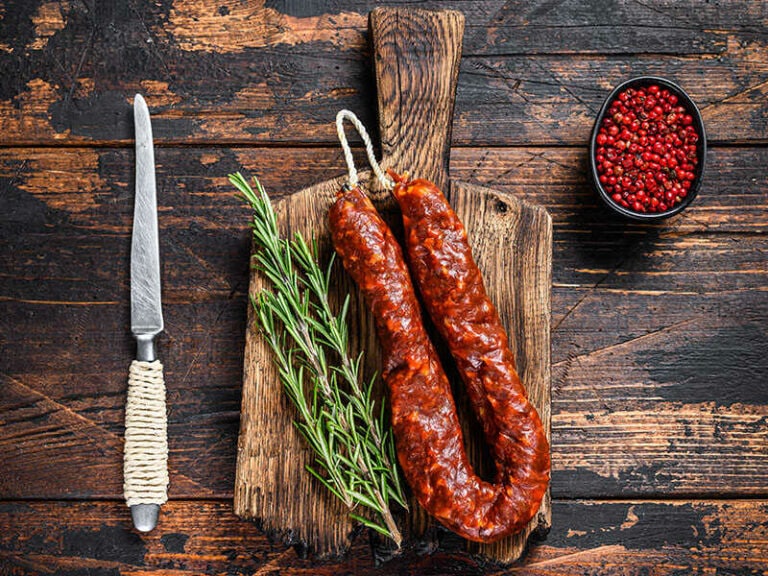For those dabbling in Spanish cuisine, you must have wondered at least one: Longaniza vs. chorizo – how are they different? If you have, then you have come to the right place. In this post, I will tell you all you need to know about these dishes.
Longaniza and chorizo are similar yet distinct dishes once you’ve learned where to look. It’s good to learn the differences to use them correctly in your meals and utilize their ambrosial flavors.
But let’s not dawdle no further, shall I? It’s time to dive in and see.

A Brief Introduction To Longaniza And Chorizo
Before any deeper analysis, let’s start with the basics first. I will familiarize you with some key information about longaniza and chorizo (if you are not familiar already), and everything else will come after.
What Is Longaniza?
Brace yourselves, as longaniza is not easy to comprehend. It’s quite complicated in its diversity, and you want to enjoy the dish to its full potential.
The Definition
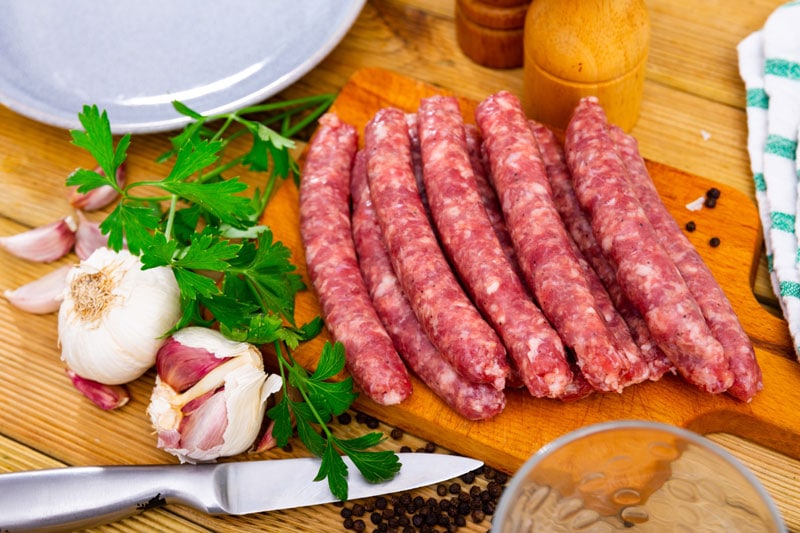
The first thing you need to know about longaniza is that it is a kind of sausage originating in Spain. Simply speaking, it’s a kind of pork sausage. The dish is popular in countries like Spain, Argentina, Uruguay, Chile, Mexico, and many more (1).
With such popularity, longaniza has many variants in each region. While the core prepping process is virtually the same, each place adds an exciting twist to the dish, making it more versatile and adaptable.
After years of development, longaniza now tastes very different from type to type. It can be spicy, sweet, citrusy, or garlicky, depending on what variant you are talking about.
Spanish longaniza is made from pork shoulder and seasoned with spices like cinnamon, nutmeg, garlic, paprika, vinegar, and anise seed. It also requires lean pork fat, and this pork is either dried, smoked, cooked, or a combination of these three.
While longaniza might resemble sausage at first glance, their main difference is that the meat used in longaniza is chopped and not ground like in sausage. This creates a deviation in texture and flavor that makes longaniza stand out from regular sausage.
Do you ever wonder how exactly longaniza comes about?
Types Of Longaniza
Traditional Spanish longaniza has a thin and long shape, a red-orange color – like dark red sausage if you need a visualization. It has a greasy texture and consistency.
However, other types of longaniza are slightly different from the traditional dish, each with its specialty. So let’s look at some of the more popular varieties:
- Argentinian longaniza: Argentinian longaniza is dried and cured pork sausage. It has a distinct aroma from anise seeds and a sweet flavor. This and the stuffing’s extremely salty taste create the perfect appetizer or sandwich stuffing.
- Filipino longaniza: The Philippines’ unique geography leads to an incredible number of variations of longaniza among the islands. In The Philippines people call the sausage longganisa, meaning spice-flavored sausages.
The color of longaniza ranges from yellow and orange to red. The added achiote seeds bring about this incredible color.
These sausages can consist of pork, chicken, beef, or tuna, with seasonings that might include garlic, brown sugar, black pepper, salt, vinegar, liqueur, anise seeds, chili, paprika, and many more. They can be sour, sweet, or garlicky.
- Mexican longaniza: The Mexican version of longaniza is long and spicy. Its ingredients include pork shoulder, sour orange juice, garlic, and achiote paste.
Despite its spicy notes, Mexican longaniza is often served during breakfast. People often mix it with eggs, tomato, and chili and eat it with tortillas as a breakfast dish.
- Puerto Rican longaniza: Puerto Rican got creative with their own version of longaniza. Longaniza can contain either pork, turkey, or chicken and is served with rice, beans, or fried plantains.
Its unique red-orange color comes from the addition of annatto seeds, and it’s often seasoned with nutmeg, garlic, and oregano, which creates a sweet, smoky, and garlicky flavor.
- Dominican longaniza: Longaniza adopts a new identity as a popular street food in the Dominican Republic. The dish is slightly salty, juicy, and fatty, with pork meat as the main ingredient.
It is often made with bitter orange or lime juice, oregano, garlic, or salt. After being cured for a few days or boiled, it is fried and served with rice, batata, fries, and tostones.

What Is Chorizo?
Have you grasped the concept of longaniza yet? I hope I have cleared everything up. Up next, let’s explore chorizo.
The Definition
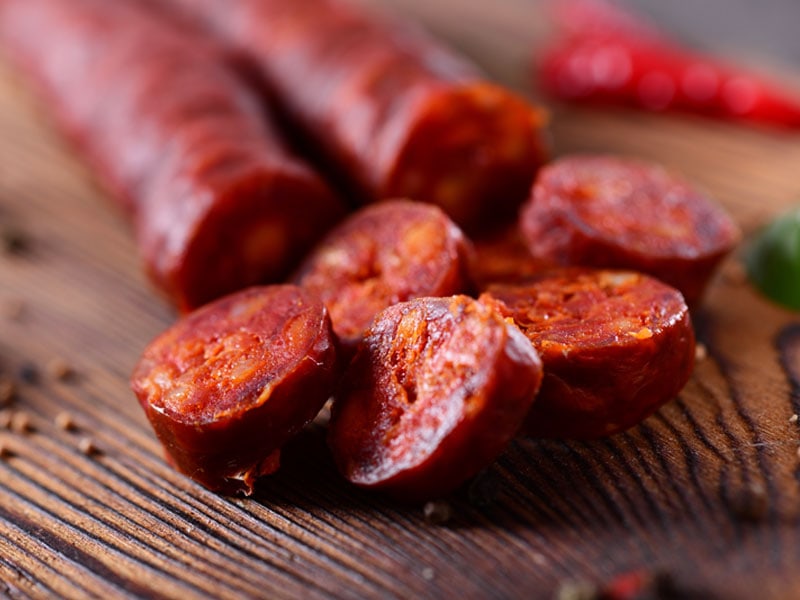
Like longaniza, chorizo also has different definitions, depending on which country. Originating from the Iberian Peninsula, the two most popular types of chorizo are Spanish and Mexican chorizo.
Besides Spain and Mexico, chorizo is also eaten in countries like Panama, the Philippines, Portugal, etc. In short, countries that were more or less influenced by Spain in the past will adopt this kind of sausage.
Chorizo is usually made from finely ground pork meat, mixed with pork fat, and flavored with salt, paprika, chili, and garlic, along with other ingredients. This combination is stuffed into casings to create chorizo.
It is often classified as Cajun sausage and is widely popular in the Cajun regions of the U.S. However, it is also acknowledged as part of Creole cuisine.
Due to its smoking process, it has a characteristic smoky, spicy flavor profile.
Making chorizo from scratch is easier than you think.
Types Of Chorizo

There are two main types of chorizo: Spanish chorizo and Mexican chorizo. Due to its strong flavor, chorizo is often used to complement other dishes instead of being eaten by itself.
- Mexican chorizo: Mexican chorizo contains raw pork (sometimes from beef, chicken, turkey, or tofu) and basic spices like cinnamon, chilly peppers, cumin, cloves, coriander, and garlic. Its color is red, and often sold in inedible casings.
Since the casings are inedible, you must remove them before cooking. Once removed, the meat will crumble and resemble ground meat when cooked. The dishes that can include Mexican chorizo are tacos, stuffed peppers, burritos, etc.
- Spanish chorizo: Spanish chorizo is made with smoked pork and can be either fully cooked or semi-cured. It is often seasoned with garlic and paprika and tastes smoky and slightly tangy. It has a unique deep brick-red color. The casings are edible.
Spanish chorizo has a similar texture to salami, which can be sliced into thin pieces. To enjoy Spanish chorizo, you just need to cut it into smaller pieces. People also add it to soups, stews, and tapas platters.
Longaniza Vs. Chorizo – What Are The Main Differences?
Here comes the main part, the reason that you are here. Longaniza and chorizo look awfully similar at first glance, which is no coincidence! However, a closer look will tell you that they are, in fact, quite different.
Ingredients
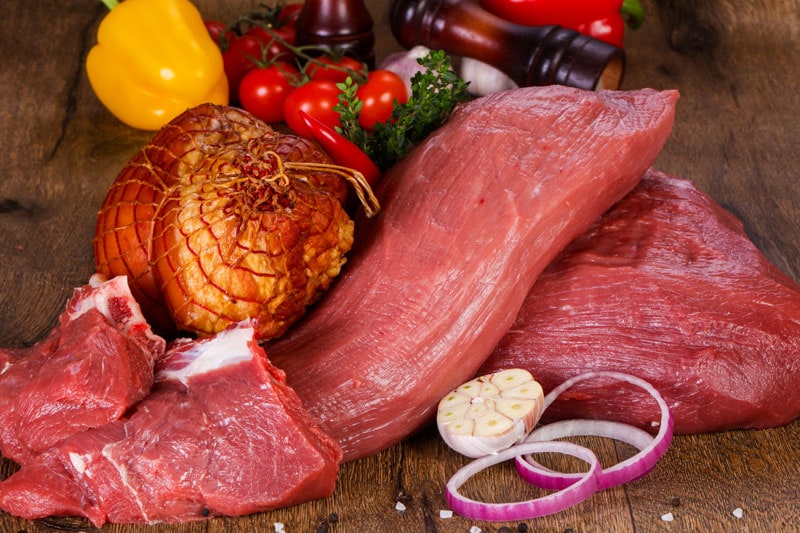
One of the main differences between longaniza and chorizo is the type of meat used for each dish.
As I have said in the previous part, longaniza has an insane number of variations, and people got really creative with the ingredients.
Longaniza is made from numerous types of meat – you can use pork, beef, tuna, or a mix of proteins. There are recipes for longaniza with mushrooms as the main ingredient. The possibilities are endless.
On the other hand, people usually use pork to make chorizo. The pork can either be raw or cured, but it must be pork.
Flavor
While longaniza and chorizo are spicy, the consensus is that longaniza is spicier than chorizo. This is because chorizo uses chili pepper, while longaniza has paprika as the main seasoning.
Chorizo can also be sweet and tangy rather than spicy, especially when it comes to Spanish chorizo.
One quick way to tell chorizo’s flavor is that those with thinner, longer shapes tend to taste mild and sweet, while those that look thick and short are savory and spicy.
Appearance & Texture

Longaniza is often sold in long and thin casings and has a dark red color due to the paprika, raw meat, and chili peppers.
On the other hand, chorizo is available in various shapes and lengths. It can be long and thin or short and thick, and the texture can be hard or soft, depending on the type. The grinding and packing process makes it thicker and chewier than longaniza.
Usage
Longaniza is usually used as sausage links, but people also remove it from the casings to include it in tacos, fried rice, and many other dishes.
While longaniza’s primary use is as sausage links, chorizo is often used as ground meat or cut into slices. People pair it with tacos, burritos, stuffed chicken, meatballs, meatloaves, and many more.
Popularity
While longaniza and chorizo are popular in Spain and Spanish-speaking countries, chorizo’s versatility makes it much more widespread globally, including in non-Spanish-speaking countries.
Production
Longaniza is often available as raw meat, which is rarely cured. You can cook, boil, fry, or grill to enjoy longaniza.
Meanwhile, chorizo is widely available in both cured and semi-cured forms.
Recipes With Longaniza
Now, enough of talking. Let’s get up and do something! Why sit here and mull over how delicious these dishes are when you can take a shot at making good food?
Dominican Rice With Sausage
I have no words to say other than this is the perfect way to start your day. Besides being nutritious and providing a hefty amount of energy, it is also warm, spicy, savory, and simply insanely delicious.
Longaniza Tacos
Are you a fan of tacos? If you are, this dish is perfect for you. Nothing can beat the crispiness of tacos, the savoriness and spice of longaniza, and the aroma of herbs. Don’t miss out on this amazing snack!
Mexican Cowboy Beans With Longaniza
Coming from Mexico, this dish is an interesting combination of flavors that can make your mouth water just from the smell of it. It is hefty and spicy but still healthy. The ideal dish for a family dinner if you ask me.
Recipes With Chorizo
If longaniza might be a tad too spicy for you, it’s okay; chorizo got you covered. Here are some of the best chorizo recipes you must try – and you won’t regret it, trust me.
Scrambled Eggs With Chorizo
You see, if you don’t like rice, then just plain scrambled eggs and some chorizo would still make a perfect breakfast. It’s not even hard to make with the ingredient count is four, all of which are easily available in anybody’s kitchen, yet it delivers the best flavor.
Chilean Chickpea Soup
This soup is what you would need, especially on cold winter days, thanks to the combination of various vegetables. Of course, you can’t forget to include Spanish chorizo as the main protein source of the soup.
Spanish Potato And Chorizo Soup
My stomach is growling just thinking about this soup. Using bacon, tomato paste, potatoes, and spices, this is the perfect soup for family dinners and gatherings. Push away the hunger with this incredible recipe.
FAQs
Was that a lot of information? If you still have questions, check the answers below to see if they help.
So, Have You Got What You Need?
I hope that this post has answered all your questions and maybe provided some further insights into two Spanish cuisine specialties: longaniza and chorizo. Now, if you stumble upon them at some point, you can tell them apart.
If you have any more questions or concerns, put them in the comment below. In case you have any interesting recipes or thoughts to share, leave them in the comment section! Don’t forget to share the article with your friends.
References
- Longaniza (2022) Wikipedia. Wikimedia Foundation.
- Longganisa (no date) Nutritionix.

